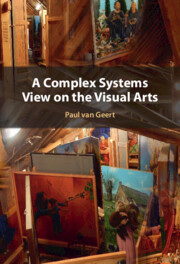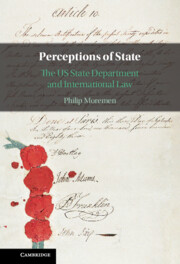100 results
Introduction
-
- Book:
- The Individual in the Law and Practice of the International Court of Justice
- Published online:
- 25 March 2025
- Print publication:
- 30 April 2025, pp 1-12
-
- Chapter
- Export citation
Chapter 3 - From Processes to Complex Dynamic Systems
- from Part I - Art as a Complex Process
-
- Book:
- A Complex Systems View on the Visual Arts
- Published online:
- 20 March 2025
- Print publication:
- 03 April 2025, pp 42-72
-
- Chapter
- Export citation
Chapter 1 - A Nonlinear Affordance for Exploration
- from Part I - Art as a Complex Process
-
- Book:
- A Complex Systems View on the Visual Arts
- Published online:
- 20 March 2025
- Print publication:
- 03 April 2025, pp 3-10
-
- Chapter
- Export citation

A Complex Systems View on the Visual Arts
-
- Published online:
- 20 March 2025
- Print publication:
- 03 April 2025
Chapter 6 - Principles and Guidelines for Teaching History
-
- Book:
- Teaching History in Higher Education
- Published online:
- 07 February 2025
- Print publication:
- 20 February 2025, pp 215-250
-
- Chapter
- Export citation
1 - An Introduction
- from I - Overview
-
-
- Book:
- Reflections on Monetary Policy after 25 Years of the MPC
- Published online:
- 14 November 2024
- Print publication:
- 21 November 2024, pp 3-9
-
- Chapter
- Export citation
2 - Background Literature
-
- Book:
- Perceptions of State
- Published online:
- 07 June 2024
- Print publication:
- 27 June 2024, pp 24-64
-
- Chapter
- Export citation

Perceptions of State
- The US State Department and International Law
-
- Published online:
- 07 June 2024
- Print publication:
- 27 June 2024
Inquiry, Questions, and Actions
-
- Journal:
- Dialogue: Canadian Philosophical Review / Revue canadienne de philosophie / Volume 63 / Issue 2 / August 2024
- Published online by Cambridge University Press:
- 15 March 2024, pp. 339-356
-
- Article
-
- You have access
- Open access
- HTML
- Export citation
Chapter 2 - Planning a Research Project:
- from Part I - Planning
-
-
- Book:
- The Cambridge Guide to Mixed Methods Research for Theatre and Performance Studies
- Published online:
- 01 February 2024
- Print publication:
- 08 February 2024, pp 59-71
-
- Chapter
- Export citation
Chapter 9 - Digital Wellbeing
-
-
- Book:
- Digital Mental Health
- Published online:
- 23 November 2023
- Print publication:
- 07 December 2023, pp 108-121
-
- Chapter
- Export citation
2 - Caring for Cultural Heritage
-
- Book:
- Caring for Cultural Heritage
- Published online:
- 09 November 2023
- Print publication:
- 23 November 2023, pp 32-55
-
- Chapter
- Export citation
Chapter 8 - Answers and Arguments
- from Part III - Delivering and Contesting Justice
-
- Book:
- Royal Justice and the Making of the Tudor Commonwealth, 1485–1547
- Published online:
- 02 November 2023
- Print publication:
- 16 November 2023, pp 203-223
-
- Chapter
- Export citation
13 - Advancing Research on Frontline Crisis Response
-
- Book:
- Frontline Crisis Response
- Published online:
- 28 September 2023
- Print publication:
- 12 October 2023, pp 208-220
-
- Chapter
- Export citation
11 - Towards a Processual Understanding of Buildings
- from Part III - New Ways of Organizing Work, Digitality and the Politics of Time
-
-
- Book:
- Organization as Time
- Published online:
- 22 June 2023
- Print publication:
- 06 July 2023, pp 229-255
-
- Chapter
- Export citation
12 - The Temporality of Entrepreneurship
- from Part III - New Ways of Organizing Work, Digitality and the Politics of Time
-
-
- Book:
- Organization as Time
- Published online:
- 22 June 2023
- Print publication:
- 06 July 2023, pp 256-274
-
- Chapter
- Export citation
Chapter 3 - Data as a Contingent Performance and the Limitations of Big Data
- from Part I - Philosophical, Epistemological and Theoretical Considerations
-
-
- Book:
- Cambridge Handbook of Qualitative Digital Research
- Published online:
- 08 June 2023
- Print publication:
- 22 June 2023, pp 28-42
-
- Chapter
- Export citation
2 - Simple Choreographies
- from Part I - Foundations
-
- Book:
- Introduction to Choreographies
- Published online:
- 11 May 2023
- Print publication:
- 25 May 2023, pp 39-54
-
- Chapter
- Export citation
3 - Simple Processes
- from Part I - Foundations
-
- Book:
- Introduction to Choreographies
- Published online:
- 11 May 2023
- Print publication:
- 25 May 2023, pp 55-75
-
- Chapter
- Export citation
Introduction
-
- Book:
- How to Measure Health Outcomes
- Published online:
- 27 April 2023
- Print publication:
- 11 May 2023, pp 1-6
-
- Chapter
- Export citation


